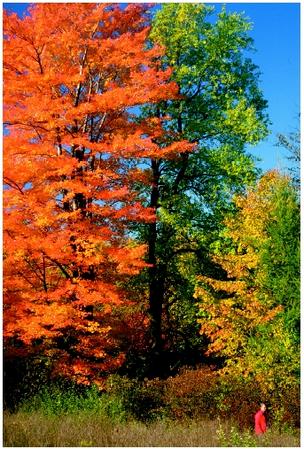Senescence
Senescence refers to all of the changes that take place in a plant that will finally lead to the death of cells, tissues, and, eventually, the whole plant body. These changes can be seen to occur in some cells even in very young, vigorously growing plants. For example the contents of those cells that make up the xylem tissue must senesce and die very early in development. The hollow cells, their cell walls arranged in a pipeline, can then allow water to flow up the plant in a process called transpiration.
Apart from the very precisely controlled death of specific cells during early development, senescence can also be seen in large, multicellular plant organs including leaves and fruits. Golden fields of ripening grain and the reds and yellows of the fall landscape in forests are both due to the pigment changes occurring during the early stages of senescence in millions and millions of leaves. The green chlorophyll pigments are removed, some yellow carotenes remain, and some species synthesize the red anthocyanin pigments at this time. Similar pigment changes occur in many fruits. These symptoms of organ senescence are often accompanied by changes in the levels of plant hormones in the cells, with shifts in the absolute amount and sensitivity towards the gaseous hormone, ethylene, playing a pivotal role.
Annual herbaceous plants live only a single growing season, with senescence occurring in all of the structures as the next generation, represented by the seeds, is shed. In perennial plants like trees, the leaves may be shed every year in a process called abscission , but the main part of the plant will continue to survive. Abscission in these deciduous plants is often considered as a part of their senescence, although the process of leaf abscission and the formation of a leaf scar is an active process. Some perennials are evergreen,

Although some individual trees and some seeds can survive for many decades or even centuries, eventually disease and other environmental challenges will lead them to their death. At that time the plant body, along with those thousands of tons of plant material returned to the soil every year, will be recycled by microbes and other soil organisms and feed a new generation of living plants.
In a world increasingly dominated by global markets for fruits, vegetables, and horticultural products, including cut flowers, people's ability to control the rate of senescence in plant tissues has become one of the most important technologies. Harvesting, transport, storage, and distribution facilities are now focused on attempts to delay the natural senescence of a huge range of living commodities. Scientists will continue to develop their understanding of the biochemistry and molecular biology of plant senescence and refine the environmental controls in storage and transport facilities so that the world's harvest can feed everyone.
SEE ALSO Hormones, Plant ; Water Movement in Plants
Roger F. Horton
Bibliography
Buckner B., D. Janick-Buckner, J. Gray, and G. S. Johal. "Cell-Death Mechanisms in Maize." Trends in Plant Science 3 (1998): 218–223.
Nooden L. D., and A. C. Leopold, eds. Senescence and Aging in Plants. London: Academic Press, 1988.
Comment about this article, ask questions, or add new information about this topic: